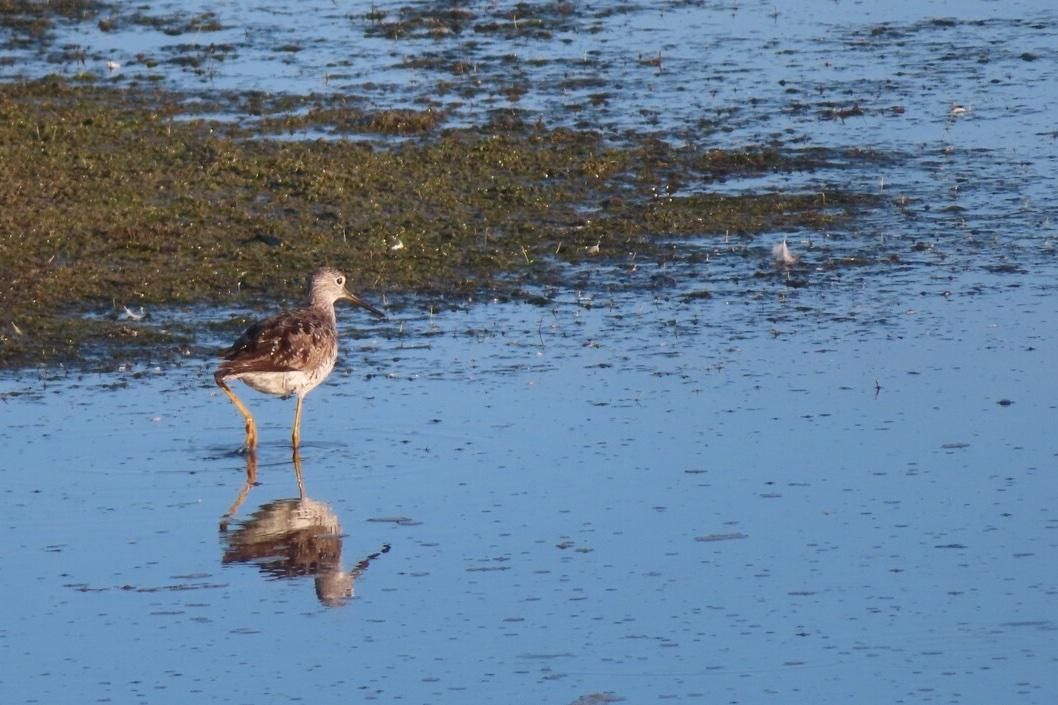Cool and crisp, dark and shady, I entered the forest steering toward the edge of the gravel where the grass would soften my step. It was quiet, just before dawn at Deer Lagoon. A crow called. All else was silent. The cacophony of spring bird song was toned down now in summer. Mating season has passed, eggs laid and hatched, and now, the young are getting bigger, growing strong. Learning to fish. Learning to fly.
The tide was out. Mount Rainier glowed faintly in the distance. I saw the silhouette of shorebirds. Yellow legs poked their beak into the mud. Killdeer called. Ducks hunkered down on sand bars in the shadows. Canada geese honked further out. Gulls perched on the posts stretching across the water. Terns swam nearby. An eagle soared toward Double Bluff. And off to the west, behind the islands of cattails, were the American white pelicans gliding along, evenly spaced, like a carnival game.
- Find out more about this Important Bird Area and how you can help protect it here.
I’d seen them at Crockett Lake in Coupeville a few days ago and wondered if I would also find them here. These summer visitors captivate my attention with their beaks as big as a shopping bag and enormous 9 foot wingspan. They fly over my house like a pearl necklace shimmering across the sky. I know they don’t really carry babies, but they seem to carry a bit of mesmerizing magic along with them. These are inland pelicans. I’ve seen them on rivers in the Midwest and on the Columbia River in Eastern Washington. It’s such a treat to have them here, too.
Last week I'd seen brown pelicans on the Olympic coast gliding just above the breakers. Once I saw a brown pelican at the Coupeville ferry which is a bit unusual. But Crockett Lake and Deer Lagoon are both official Important Bird Areas with global significance according to an internationally agreed upon set of criteria. It’s not unusual to find people carrying binoculars and spotting scopes at either place. Deer Lagoon is considered one of the best birding spots on Whidbey Island. Over 200 species have been documented here. This morning, I was the one with a camera and binoculars.
As the sun came up, I met dog walkers, a woman walking with ear buds, and a cyclist passed by. The birds also grew more lively. Shorebirds were flying back and forth, flashing dark and light, dark and light. Great blue herons perched on posts or fished in the shallows. Clouds of bugs erupted out of the channel like a column of smoke. I stood in the shade of a tall blackberry bush which was surprisingly bug-free. Schools of fish made patterns across the water in the wetlands. A heron stood in the same spot catching one fish after another. As I reached the far end of the trail, I noticed a heron perched on someone’s basketball backboard.
Turning back, I met more people and dogs out for their morning walk. An osprey soared over the water. Redwing blackbirds and marsh wrens fussed from the cattails. As I returned to the trees I noticed sparrows, towhee and chickadees in the shrubs along the trail. Fireweed blossoms attracted a hummingbird. I picked some blackberries for breakfast, their sweet taste of summer waking my tastebuds. I licked the purple juice from my fingertips and smiled. What a wonderful way to start a day.
Directions
Directions: Take Highway 525 to 1 mile south of Freeland. Turn south on Double Bluff Road. In about a half mile turn left onto Millman Road and right on Deer Lagoon Road. Park near the end. Please don’t block the driveways.
By Bus or Bike: Island Transit’s fare free Route 1 and Route 60 buses stop at Double Bluff Road and Highway 525. From there the road is almost level and has a shoulder for walking or biking about 1 mile to the trailhead. Wear something bright if using the road shoulder. Two bikes fit on a bus bike rack. For the latest bus schedule, click here.
Trail Conditions: This is a short, flat, gravel trail with easy access for those with mobility challenges. It’s less than a mile round trip.
Republished with permission. Read the original article.
